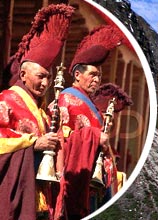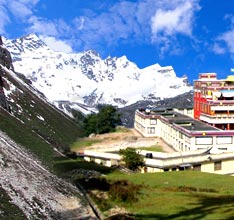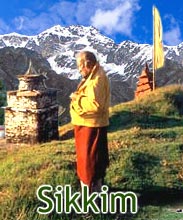 Festivals
bring liveliness and fun in the monotony of daily life. India is a land
of festivals and Sikkim, being a part, doesn't stay behind. The people
of Sikkim celebrate scores of festivals with full gusto and fervor.
Since, there are people from diverse religions in Sikkim, so they all
have their own festivals to celebrate. However, the mutual harmony
amongst dwellers paints the whole state in the colors of festivities. In
this section, we will discuss the major festivals of Sikkim in detail.
Festivals
bring liveliness and fun in the monotony of daily life. India is a land
of festivals and Sikkim, being a part, doesn't stay behind. The people
of Sikkim celebrate scores of festivals with full gusto and fervor.
Since, there are people from diverse religions in Sikkim, so they all
have their own festivals to celebrate. However, the mutual harmony
amongst dwellers paints the whole state in the colors of festivities. In
this section, we will discuss the major festivals of Sikkim in detail.Buddhism appears to dominate the religious lives of maximum number of people. Perhaps, Hinduism is the major religion practiced by the Nepalis. The Tibetans, the Sikkimese and the Bhutias usually practice Buddhism. In the vein of tolerance, Christians, Sikhs and Muslims also flourish along with followers of other religions. In Sikkim, Hindu festivals like Dasain/ Dusshera, Tihar/ Diwali, Saraswati Puja, Maghe Sakranti, Janmastami, Vishwa Karma Puja, Holi and Ramnavami are celebrated with the same enthusiasm like that in any other part of the country.
There are several other festivals like Namsoong, Sakewa, Bhanu Jayanti, Tendong-Lho-Rum-Faat, Teyongsi Srijunga Sawan Tognam, Christmas, Tamu Lochar and Nyempa Guzom. The festivals of Buddhists include Saga Dawa, Lhabab Dhuechen, Drukpa Tsheshi, Phang Lhabsol, Losoong, Losar, Bumchu, Trungkar Tshechu, Kalchakra Puja and Kayged Dance. Being influenced more by the Buddhism, the following articles elaborate on the festivals of Buddhists.
Lhabab Dhuechen Festival
Lhabab Dheuchen represents the descent of Lord Buddha from the heaven after teaching his deceased mother, Mahamaya. The literal meaning of 'Dhuechen' is 'festival', whereas 'Lha' means 'heaven' and Bab means 'descent'. The festival has a legend behind its celebration. The festival falls on the 22nd day of the ninth month of Lunar Calendar every year. The Buddhists celebrate this event with all zest and zeal in Sikkim.
Losoong Festival
The conclusion of harvest season is marked by Losoong. This festival also suggests the end of the 10th month of the Tibetan Year. With the celebration of Losoong, a prayer is sought for good harvest and better prospects for the subsequent crop. During the festival, dance is performed by Chaam at monasteries of Tsu-La-Khang, Phodong and Rumtek. Losoong is also marked by event of archery competition.
Losar Festival
Losar is celebrated usually in the month of February. Actually, the Sikkimese' share their new year with the Tibetans. The youth mostly comprising Tibetans take out procession in the streets of Sikkim. On the festive day, Yak dance is also observed. People throw sampa, which is a kind of greeting and welcoming the New Year with screams of 'Tashi Delek'. The Tibetan community involves itself in the festivity a week prior to the day.
Guru Rimpoche's Trungkar Tshechu
The festival is celebrated to honor Guru Rimpoche, who was the first Sikkimese Buddhist to bless Sikkim. He is considered as the master, who actually enrooted the religion of Buddhism in Sikkim. He introduced 'tantric' Buddhism to the Himalayas, after conquering 'demons' that were hindering the growth of religion in Tibet. It is believed that on this festive day, recitation of mantras brings two-fold benefits to the speaker.
Kagyed Dance Festival
Kagyed Dance is performed on the 28th and 29th day of the 10th month of the Tibetan Calendar, somewhere in December. The dance portrays the destruction of evil forces and wishing for peace & prosperity in Sikkim. Popular Chaams (Monks) perform this dance in the company of music and chants. The jovial gestures of jokers provide some comic relief to the somber nature of dance. The various dance performances depict several themes from the Buddhist mythology. A sharp effect is produced with smoldering of effigies made out of flour, wood and paper.
Kalchakra Puja
The literal meaning of Kalchakra is the 'vicious circle'. For the whole life, people crave to leave this circle of life and death and eventually attain 'nirvana' or enlightenment. In the festival, a worship of 'Tantrayana' is offered to the Almighty. This worship depicts the 'tantric' or mystic feature of Buddhism along with complex and obscure rituals.








